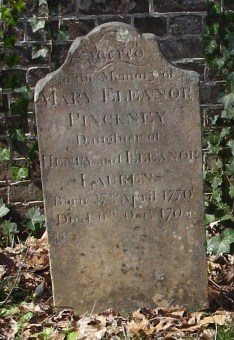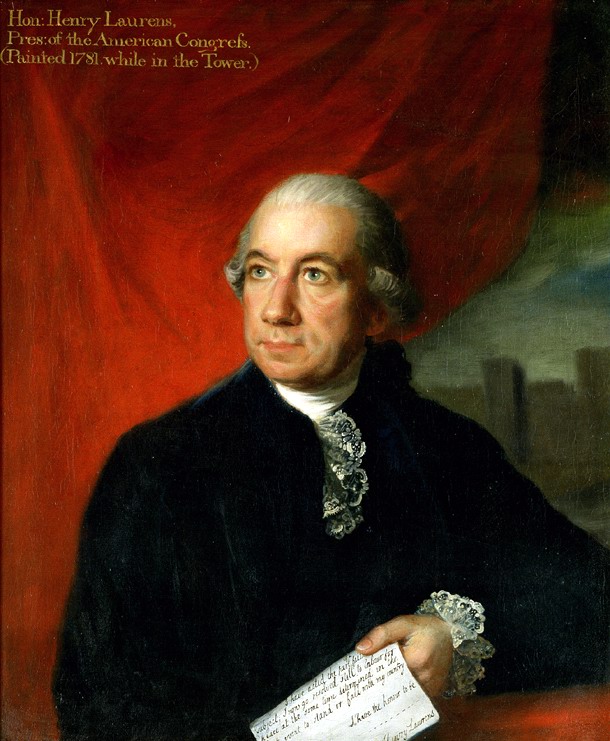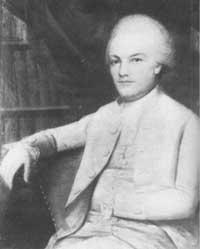Mary Eleanor Laurens and Transgender History Part II

A little over a year ago I wrote an article entitled “Mary Eleanor Laurens and Transgender History.” In that article, I told the story of Mary Eleanor “Polly” Laurens Pinckney, who as a six year old told her family she wanted to be a boy. I debated whether six-year-old Polly Laurens was a girl who did not like the way girls in her society were treated, or whether she may actually have been a transgender boy. Ultimately I decided that though it seems entirely possible that Laurens was transgender, there was no clear evidence either way. In honor of 18th Century Pride’s two-year anniversary, my Patrons voted for Polly Laurens’s story to get a second look.
The Papers of Henry Laurens

The first step I took in my reattempt at discovering Polly Laurens’s story was to make use of my newly acquired access to the papers of her father, Henry Laurens. When I researched Laurens the first time, I only had access to snippets of her father’s writings posted online by other researchers. I started with Volume 11, which covers the year Laurens made her declaration. I found a few mentions of Polly Laurens: her father Henry mentioned that she was her aunt’s favorite of the Laurens children, and her brother John mentioned that “Polly…will be skipping and galloping about the room in spite of all their Efforts to restrain her.”¹ Eventually I arrived at the passage that sits at the center of this story. On April 26th, 1776, John Laurens wrote to his father:
“Sweet little Polly is the admiration of every body. We both agree that my Aunt does not exercise authority enough over her. But it can scarcely be wondered at. A Person in my Aunt’s Circumstances with respect to Polly, would rather wish the world to say she is too indulgent, than too severe; and a Desire to avoid one extreme, often leads to another which ought equally to be shun’d. But with all my Aunts Mildness, Polly thinks the Restrain incident to her Sex, very mortifiying. And asked with as much Gravity as Innocence, if they would not let her wear breeches and become a Boy. She envied Harry his freedom very much and would wish to be upon the same footing with him. When she was told this Change would not be effectual – she proposed what she thought would infallibly answer the purpose – to be re-christen’d, and have a male name.”²
I did a thorough analysis of this passage in my previous article, so it is not necessary to do so here. Having the rest of Henry Laurens’s papers did provide interesting context though. What surprised me was that, other than Henry’s response to this particular incident (“A narrative of the history of Joan of Arc may cure the little Maid’s ambition for Breeches,”³) none of the authority figures in Polly Laurens’s life seemed to have any complaints about her. Henry Laurens was very traditional, in one letter reminding his daughter Patty that it was more important that she learn to cook than that she continue with her study of geography.⁴ John Laurens too could be traditional in his views about women. As I mentioned in my previous Polly Laurens article, he felt their sister Patty did not do enough to become graceful.⁵ I do not know much about the views of Polly Laurens’s aunt and uncle, with whom she was living at the time, but it does not seem out of line to guess that they were similar to the views of Henry and his son. With all of this in mind, one would think that if Polly Laurens was constantly rebelling against gender norms, they would have been a little less happy with her. Instead Henry continues to describe Polly as her aunt’s favorite, at one point noting to John: “your other Sister is at an Age and has qualities to make her Foster Mother happy.”⁶ One explanation is that Polly may have gotten away with things because of her age. Perhaps her family assumed that she would eventually grow out of galloping around the room and begging to wear pants.
All of this has led me to the conclusion that what I really need to do to figure out Polly Laurens (and what I will do if I ever get another chance to revisit this topic) is to look more at her adult years. Did Laurens submit to gender norms and womanhood as she grew older? Did she become something of a proto-feminist? And did her frustration at the way she was treated continue to include hints that she could have been transgender?
The Papers of Charles Pinckney

I was unable to access the volumes of Henry Laurens’s papers from the time when Polly was older, although I hope to be able to eventually. I did however get a few glimpses into the adult life of Polly Laurens through some of the papers of her husband, Charles Pinckney.
As I described in my first article, the main takeaway from Pinckney’s writings about his wife is that he was using her. Although many writers try to make his habit of referring to as “little French girl”⁷ seem cute, Pinckney actually did this to market himself to prominent politicians, including George Washington, whom he believed might give him a job; Pinckney believed that having a wife who had spent so much of her young life in France made him uniquely qualified to serve as ambassador to France.⁸ Pinckney also frequently reminded Washington and others that being married to Polly Laurens meant he was related to Henry Laurens (still a prominent political figure), John Laurens (by this time a fallen war hero), and the Laurens family fortune.⁹ Beyond that, she was his “female secretary” and a woman who could provide him with sons.¹⁰
Charles Pinckney’s papers, or at least those I could access, tell us nothing about Polly Laurens’s gender identity. She served his purposes, whether she was a rebellious woman or even a transgender man, so long as he could present her as a cultured parisian heiress.
Laurens must have had her own reasons for wanting to marry Pinckney though. She initially told her father she wanted to marry him when she was just sixteen years old, and her father made her wait until her eighteenth birthday.¹¹ While Pinckney may have been willing to wait to secure such a valuable wife, Laurens’s insistence and dedication seem to suggest she felt some love for the man. From this we can tentatively say that whatever Polly Laurens’s true gender identity, she was attracted to men.
Polly Laurens and the Trans Experience
Having gotten all we can from those two sources, let us return to the main question I asked in my original article: was six-year-old Polly Laurens just rebelling against gender norms because she did not like how girls were expected to behave, or was it because she was actually a transgender boy?
In that article I used the example of trans activist Jazz Jennings to show that it is possible for a transgender person to know they are trans from a very young age. Since then however I have learned that not only is it possible, but it happens all the time. Trans rights podcaster Marlo Mack cited Dr. Kristina Olson, a psychologist from Princeton, whose research has shown that a significant group of trans people know they are trans from the time they are in preschool.¹² This is not to say that all trans people know by that age; some do not know until their adolescent or teen years, and others do not know until well into adulthood. What this does show is that Polly Laurens’s story, if it is the story of a transgender boy, would not be at all unusual.
It makes sense that Laurens could have been trans. Does it make as much sense that she could have been a girl who recognized gender inequality, at six years old? As I discussed in my previous article, yes. At six Laurens’s life would have been diverging sharply from that of her slightly older brother Harry. In my other article I discussed the issue of stays. At six years old, Polly Laurens was right around the age where she learned that unlike her brother Harry, she would be wearing stays for the rest of her life.¹³ Stays could be comfortable, but they were physically restrictive, and John said that Polly liked to be physically active more than any member of her family. Additionally, there is the issue of her education. At six Harry was sent to a boarding school. Polly it seems was educated by her aunt and by her older sister.¹⁴ It is hard to say whether her different method of education, or even her different garments, caused Polly Laurens great distress. But it can definitely be said that Laurens would have noticed a difference.
We are once again faced with the question then of whether Polly Laurens was a rebellious girl, or a transgender boy. At the end of my previous article I said that there was no evidence that Polly Laurens was transgender, but that is not quite true; more accurately, there is no more evidence for one option than for the other. They are equally likely. I am looking for a piece of evidence that will tip the scales one way or the other, but I have not found it yet. I hope I may find this in Polly Laurens’s later life. But what will this evidence look like? What kind of evidence could make a question like this clearer? These are important questions for researching anyone in history whose relationship with gender was not what we expect. But they are also important specifically for Polly Laurens, who deserves to be understood.
- John Laurens to Henry Laurens, 20 March 1776, accessible in Volume 11 of The Papers of Henry Laurens or online here: https://john-laurens.tumblr.com/post/108946992508/harry-enjoys-vigorous-health-nor-does-he-want-the
- John Laurens to Henry Laurens, 26 April, 1776, The Papers of Henry Laurens Vol. 11
- Henry Laurens to John Laurens, 3 February 1777, The Papers of Henry Laurens, Vol. 11
- The Papers of Henry Laurens, Vol. 11
- See #2
- Henry Laurens to John Laurens, 14 August 1776, The Papers of Henry Laurens, Vol. 11
- Biographies – Department of History | University of South Carolina (sc.edu)
- Charles Pinckney to James Madison, 6 August 1791, https://founders.archives.gov/documents/Madison/01-14-02-0061
- Charles Pinckney to George Washington, 14 December 1791, https://founders.archives.gov/documents/Washington/05-04-02-0285
- Charles Pinckney to James Madison, 28 March 1789, https://founders.archives.gov/documents/Madison/01-12-02-0030
- John Laurens and the American Revolution, George Massey, 316
- “Where in the World Are All the Trans Children? Everywhere.”, Marlo Mack, Opinion | Transgender Children Are Everywhere – The New York Times (nytimes.com)
- https://janeaustensworld.wordpress.com/tag/18th-century-children/ and (33) A Dress Historian Explains the Difference between Corsets and Stays – YouTube
James Laurens to Henry Laurens, 18 September 1777, The Papers of Henry Laurens, Vol. 11
7 Strange Things
This was a really interesting article, I knew nothing about the Laurens family. The question of gender and identity in history is fascinating because there is so much evidence transgender people existed, we just struggle with the context.
In the case of Polly it would be intriguing to learn more of her later life and whether she did eschew more norms as she grew. The cut and dry cases are simple but its people like Polly that interest me, I wonder who she’d be or identify as today.
For your final question I’d say looking at sources (if there are any) of friends, social circles might be where the clues are. Or even the absence of herself at notable events her husband attends could be telling (refusal to wear traditional female clothing?).
Anyway I’m musing, thanks for the read, I like anything that shines a spotlight on the unfairly forgotten.
megangack
Transgender history presents many obstacles we must grapple with, and that was part of what made writing these two articles on Polly Laurens Pinkney so fun. I really learned a lot about the field itself.
I definetly think if there are answers to be found they will be found in P. Laurens’s later life. I think looking at her later years will make it easier to tell if she was trans or just a proto-Feminist than looking at her childhood years. I like your idea of looking at documentation from her friends to see how she behaved in social situations, I think that could tell us a lot.